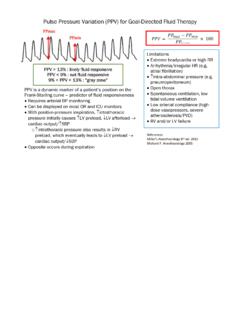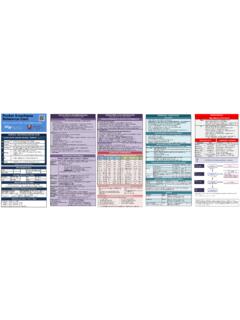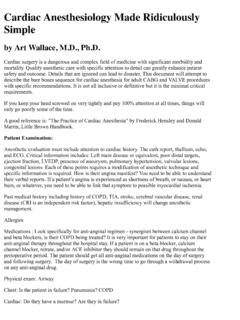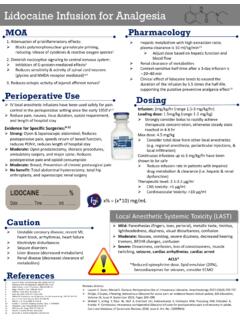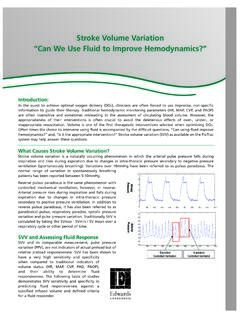Transcription of UCSF Guideline for the Perioperative Management of ...
1 UCSF Guideline for the Perioperative Management of BuprenorphineSurgical team/ Prepare Clinic identifies patient on buprenorphine (ButransTM, SuboxoneTM, SubutexTM, ZubsolvTM, BunavailTM, BelbucaTM, TemgesicTM, ProbuphineTM, BuprenexTM, )Minimally painful ambulatory and inpatient surgery(no or minimal need for postoperative opioid therapy expected such as endoscopy, cataracts, FESS etc)Continue home dose through procedure day and after discontinuation or holding of buprenorphine EmergentOperation Urgent/ ElectivePatients on lower doses of buprenorphine:Transdermal Buprenorphine (ButransTM patch), any doseProbuphine implantsBelbuca, any dose< 8 mg/day suboxone /Subutex, < mg/day Zubsolv, < mg/day BunavailPre-operative dose adjustment not possible.
2 Anticipate need for high doses of opioidsConsult acute pain serviceConsider postoperative ICU stay after surgeryPREPARE Clinic Contact buprenorphine prescriber: patient to reduce dose to <8mg/day suboxone /Subutex,< Zubsolv, < of Bunavail by time of and record prescriber name and contact information inPREPARE noteConsult acute pain service if inpatient surgery (stay > 23 hours)Surgical Team Contact buprenorphine prescriber to discuss gradual dose reduction or discontinuation in anticipation of elective surgerySchedule Prepare Clinic appointment not later than one week before surgerySURGERYP erioperative plan per OR Anesthesia team/ Regional Anesthesia team - Use non- opioid analgesics (gabapentin, pregabalin, acetaminophen, NSAIDS)
3 Pre-operatively if not contraindicated - Use continuous regional anesthesia techniques if possible (epidural and peripheral nerve catheters) - Use IV ketamine, lidocaine intra-operatively if not contraindicated - Discuss pros and cons of delaying surgery for patient optimization if patient is still taking a higher dose of buprenorphine (>8mg suboxone or equivalent dose) Anderson TA et al, To Stop or Not, That Is the Pain Management for the Patient on Chronic Buprenorphine. Anesthesiology 126, 1180 1186 (2017). Fudin J. A Brief Review of Buprenorphine Products. Pharmacy Times; March 22, is a unique opioid that has the highest affinity to the mu receptor than any other clinically-used opioid .
4 For this reason, it can block other opioids from being used, and result in withdrawals if started inappropriately. It requires pre-surgical planning and coordination of teams to avoid major complications. AFTER SURGERYThe acute pain service (APS) will be following all patients postoperatively. Postoperative Multi-Modal Analgesia Plan Per APS - Maintenance or placement of axial or peripheral nerve catheters, or short-term nerve blocks as necessary - Focus on non- opioid medication (gabapentinoids, acetaminophen, NSAIDs, antidepressants, 2 agonists etc.) - Use full agonist opioid with high binding affinity (hydromorphone, fentanyl, or sufentanil) orally, IV, or by PCA - Avoid use of long-acting opioids!
5 - Continuation of buprenorphine, at home dose, lower dose, or higher dose - Consider Ketamine infusion protocol (1-5mcg/kg/min infusion) - Use Non-medication/non-procedural adjuncts (acupuncture, pet therapy , PT and mechanical supports as appropriate) - Consider Chronic Pain Service consult in more complex patientsBuprenorphine Re-Induction Planning should not be necessary if patients continued to take buprenorphine during their hospital stay. If buprenorphine was discontinued, the pain service attending decides in collaboration with the buprenorphine prescriber and the UCSF Pain Management Center which re-induction strategy is appropriate. Painful ambulatory and inpatient surgery.
6 Expected need for postoperative opioid therapy . Patients taking higher daily doses of buprenorphine that would interfere with intra- and postoperative opioid therapy need to be identified. These are patients taking more than the equivalent of 8mg suboxone / on higher doses of buprenorphine use:> 8 mg/day suboxone /Subutex, > mg/day Zubsolv, > mg/day BunavailNo preoperative dose adjustment neededContinue home dose through procedure day and after dischargeConsult acute pain serviceif inpatient surgery (stay > 23 hours)Approved by P&T Committee 1/10/18 Approved by Pain Committee 1/17/18

